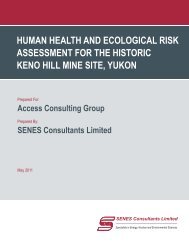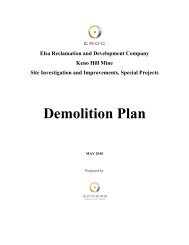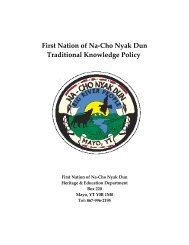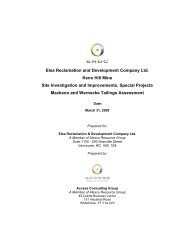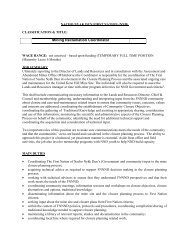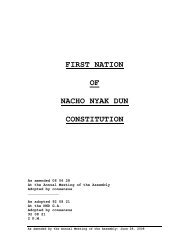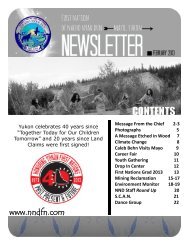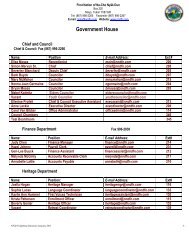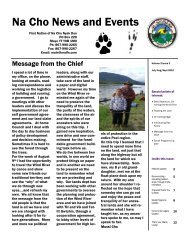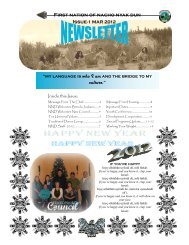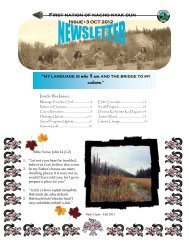Northern Tutchone Dictionary - First Nation of Na-Cho Nyak Dun
Northern Tutchone Dictionary - First Nation of Na-Cho Nyak Dun
Northern Tutchone Dictionary - First Nation of Na-Cho Nyak Dun
You also want an ePaper? Increase the reach of your titles
YUMPU automatically turns print PDFs into web optimized ePapers that Google loves.
<strong>Northern</strong><br />
<strong>Tutchone</strong><br />
<strong>Dictionary</strong>
Introduction<br />
The NND Language Alphabet<br />
The Mayo <strong>Na</strong>tive Language Alphabet<br />
Mammals<br />
Birds<br />
Fish<br />
Trees and Plants<br />
Insects and Small Creatures<br />
Parts <strong>of</strong> the Body<br />
Body Products and Diseases<br />
Relatives<br />
People<br />
Land and Water<br />
Sky and Weather<br />
Seasons and Days<br />
Numerals<br />
Contents<br />
Colours<br />
Transportation<br />
Fishing and Hunting<br />
Tools<br />
Clothing<br />
Food<br />
Fire<br />
Buildings<br />
Furnishings<br />
Cooking and Eating Utensils<br />
Other household items<br />
Emotions<br />
Medicine, chew<br />
Office, department<br />
Abstract<br />
Place names
Introduction<br />
Very possibly, there was an English corruption <strong>of</strong> the native word for “wood” or “stick”, Dechan. Early visitors to the<br />
region reported that the native people were called “Wood Indians” or “Stick Indians” and even today the term Dechan to<br />
hot‟yan (“people who live in the woods”) is recognized as the true name for the natives <strong>of</strong> Stewart Valley. Thus is it probable<br />
that the <strong>Tutchone</strong> is an imperfect spelling <strong>of</strong> the word Dechan.<br />
To the native people themselves, their language is simply called dan dha‟ (“man‟s speech, person‟s speech”). It is very<br />
closely related to the languages <strong>of</strong> Pelly Crossing, Carmacks, Little Salmon, and Big Salmon – all <strong>of</strong> which are also called<br />
<strong>Northern</strong> <strong>Tutchone</strong> – and is somewhat less closely related to the languages <strong>of</strong> Lake Laberge, Whitehorse, Champagne,<br />
Haines Junction, and Burwash – which are all called Southern <strong>Tutchone</strong>. The use <strong>of</strong> <strong>Tutchone</strong> for all these speech varieties<br />
implies that, to a greater or lesser degree, they are all mutually intelligible, i.e. that the people who speak these languages can<br />
understand one another.<br />
<strong>Northern</strong> and Southern <strong>Tutchone</strong> are two members <strong>of</strong> the great Athapaskan language family. Athapaskan languages are<br />
spoken in three distinct geographical areas <strong>of</strong> the Western Hemisphere: the American Southwest (Arizona, New Mexico), the<br />
Pacific Coast (Oregon and <strong>Northern</strong> California), and the far North including most <strong>of</strong> the interior <strong>of</strong> Alaska and a large section<br />
<strong>of</strong> the N.W.T, Yukon and B.C. In fact, all <strong>of</strong> the <strong>Na</strong>tive languages in the Yukon Territory except Tlingit (Carcross, Teslin)<br />
belong to the Athapaskan family.<br />
The first part <strong>of</strong> this dictionary gives examples <strong>of</strong> the use <strong>of</strong> the new alphabet. This writing system is based on the<br />
structure <strong>of</strong> the native language, not on English, and it will require some practice to become familiar with its symbols and<br />
conventions. The aim has been to provide a letter, or set <strong>of</strong> letters, for each <strong>of</strong> the distinctive sounds <strong>of</strong> the language so that<br />
there will be no confusion about how a letter should be pronounced. Hopefully this will make it easier for people to learn and<br />
read and write the language. Please study this section carefully before going on to the main body <strong>of</strong> entries; it will make the<br />
reading a lot easier.<br />
All <strong>of</strong> us who have had to hand in preparing this booklet hope that it will serve to reveal some <strong>of</strong> the beauty and richness<br />
<strong>of</strong> the Mayo language and will encourage people to keep it alive by using it more. It is a priceless thing heritage, which has<br />
been passed down from generation to generation. Once lost, it can never be regained.<br />
Finally, this version <strong>of</strong> the new Mayo dictionary probably contains mistakes <strong>of</strong> one kind or another. Please let us know if<br />
you find any, and also let us know <strong>of</strong> other words which you think we should put in next time.<br />
The NND Language Alphabet<br />
Consonants<br />
John Ritter,<br />
Whitehorse, Yukon<br />
The new alphabet has letters or letter combinations for the consonant sounds <strong>of</strong> the language. Each one is listed below,<br />
along with an example <strong>of</strong> its use in a whole word.<br />
tl tlin dog dl dlu toboggan
tl‟ tl‟o grass<br />
ł łéki two<br />
l ledyát tea<br />
t tun trail<br />
d dun man, person<br />
t‟ t‟o cottonwood (tree)<br />
tth tthi rock, stone<br />
ddh ddhaw mountain<br />
tth‟ tth‟é‟ plate, dish<br />
th thí‟ dog salmon<br />
dh edhό‟ skin<br />
ts tso wood<br />
dz dzun muskrat<br />
ts‟ ts‟ok tree, spruce<br />
s sán‟ star<br />
z lezé‟ money<br />
tr trá‟ arrow<br />
dr edrún‟ it itches<br />
t‟r et‟rό‟ kidney<br />
shr shru inconnu fish<br />
zr dezra cow moose<br />
ch dechan stick, wood<br />
j jak berries<br />
ch‟ dech‟ok porcupine<br />
sh shan summer<br />
zh zha snow<br />
k kún‟ house<br />
g gun snake, worm<br />
k‟ k‟I birch<br />
kh khaw sled<br />
gh ughú‟ his tooth<br />
kr lawkra‟ butterfly<br />
gr k‟όngrun doll<br />
k‟r k‟ro alder tree<br />
khr khro thorn<br />
ghr eghrό‟ egg<br />
kw kwán‟ matches<br />
gw dan gwόt man‟s knee<br />
kw‟ dunkw‟an short (person)<br />
khw khwat axe<br />
ghw ughwán‟ his raft<br />
„ u‟yáák his shirt<br />
h Mayo níhizhe I‟ve been to Mayo<br />
m man lake<br />
mr mra knife<br />
n nu island<br />
nr to nru night time<br />
tl‟r dentl‟run blue, green<br />
tr tro urine<br />
lr Coast indians<br />
y yáw‟ beads<br />
Vowels<br />
The vowels can be easily written with English letters, but they do not have exactly the same sounds or “values”<br />
as their English counterparts. Here is a list <strong>of</strong> them, along with a short description <strong>of</strong> their approximate English sounds. Note<br />
especially the importance <strong>of</strong> the letters h, „, and n when they stand together with the vowels.
1. i has the sound <strong>of</strong> the vowel e in English see, bee. Examples:<br />
tthi rock, stone<br />
hudzi caribou<br />
tutsi robin<br />
2. i‟ has the sound <strong>of</strong> the vowel in English see, bee, but it is shorter and ends with a sharp, abrupt stop. Note that „ is a<br />
separate letter and is called a “glottal stop”. It can occur with all the vowels, not just with i. Examples:<br />
dan kí‟ man‟s foot<br />
dan dzí man‟s heart<br />
dan tthí‟ man‟s head<br />
3. u has the sound <strong>of</strong> the vowel in English flute. Examples:<br />
tu water<br />
dlu toboggan<br />
shru inconnu fish<br />
4. u‟ has the sound <strong>of</strong> u but shorter and ends with a sharp, abrupt stop. Examples:<br />
Dan ghú‟ man‟s tooth<br />
udlú‟ his toboggan<br />
hutú‟ their water<br />
5. e has a sound which varies between the e <strong>of</strong> English met and the a <strong>of</strong> English make, cake. It is <strong>of</strong>ten preceded by a short<br />
“y” sound, giving the impression <strong>of</strong> “eeya” or “aya”. Some examples <strong>of</strong> e :<br />
e snowshoe<br />
ge rabbit<br />
se sun<br />
naye wolverine<br />
6. e‟ has the sound <strong>of</strong> e but ends with a sharp, abrupt stop. Examples:<br />
Lezé‟ money<br />
tsé‟ beaver<br />
uté‟ his father<br />
7. o has the sound <strong>of</strong> the vowel in English hoe, bow. Examples:<br />
tso firewood<br />
cho big
tagok swan<br />
8. o‟ has the sound <strong>of</strong> o but ends with a sharp, abrupt stop. Examples:<br />
tádó‟ driftwood<br />
utsó‟ his wood<br />
zehnyó‟ pintail duck<br />
9. a has two sounds, depending on where it appears in the word. When it is the last letter <strong>of</strong> the word, it has the sound <strong>of</strong><br />
English a as in father. Examples:<br />
ta wave<br />
tahna ice chisel<br />
dya crane (bird)<br />
When a is the last vowel <strong>of</strong> the word but is followed by any letter except „, it has the sound <strong>of</strong> the vowel in English above,<br />
about, around. Examples:<br />
dan dzák man‟s ear<br />
man lake<br />
mat food<br />
10. aa occurs only in the middle <strong>of</strong> a word and has the sound <strong>of</strong> the vowel in English father. Examples:<br />
tádlaat water moss<br />
tats‟aat sucker fish<br />
dan náák man‟s eye<br />
11. a‟ has the sound <strong>of</strong> the vowel in English father but is shorter and ends with a short abrupt stop. Some examples <strong>of</strong> á‟:<br />
má‟ mitts<br />
trá‟ arrow<br />
umrá his knife<br />
12. ay has the sound <strong>of</strong> the vowel in English tie, buy. Examples<br />
thay belt<br />
agay wolf<br />
tuhtsay loon<br />
etsay he is crying<br />
13. ay‟ has the sound <strong>of</strong> ay but is shorter and ends with a sharp abrupt stop, as in:<br />
udháy‟ his belt<br />
ihtáy‟ my uncle (father‟s brother)
deláy‟ bell<br />
14. aw has the sound <strong>of</strong> the vowel in English how, cow. Examples<br />
aw spruce boughs<br />
ddhaw mountain<br />
dahdzaw cache; bed<br />
15. aw‟ has the sound <strong>of</strong> aw but is shorter and ends with a sharp, abrupt stop. Examples:<br />
dan damáw‟ man‟s lips<br />
edláw‟ he is laughing<br />
yáw‟ beads<br />
Vowels + h<br />
Certain combinations <strong>of</strong> “vowel plus h” are found within words. The h adds a breathy quality to the vowels<br />
and gives them a distinct sound. Here are some examples:<br />
i + h nihtsi I pick (berries)<br />
ihtsí‟ my grandfather<br />
u + h tuhtsay loon<br />
e + h tehdru otter<br />
o + h k‟oht‟yan Whiteman<br />
a + h dahdzaw cache; bed<br />
<strong>Na</strong>salized vowels<br />
Some vowels in the Mayo native language are pronounced with air coming through the nose, and<br />
they are called nasalized vowels. We indicate them by writing the letter n after the vowel. Some examples:<br />
i + n tlin dog<br />
utsin his nose<br />
unín‟ his face<br />
u + n gun worm<br />
jun here<br />
kún‟ house<br />
Here is an important spelling rule: After the vowels I and u the letter n <strong>of</strong>ten sounds like ng. This means<br />
that tlin may sound like tling, for example, and kún‟ may sound like kúng‟. Since this ng is always predictable,
occurring only after i and u, we don‟t have to write the g in the word. Instead we only write the n and read the g-part<br />
out automatically after the vowels i and u. Some examples <strong>of</strong> this rule:<br />
tlin “tling” dog<br />
utsin “utsing” his nose<br />
unín‟ “uníng‟” his face<br />
The other nasalized vowels are as follows:<br />
e + n huchen it‟s raining<br />
utthíyén‟ his brain<br />
ihden I‟m drinking<br />
o + n dahdzyon bee<br />
ts‟onk‟e camp robber<br />
kahdzyona swallow bird<br />
a + n shan summer<br />
dan man<br />
man lake<br />
aa + n shra aan bear hole<br />
dan gáán‟ man‟s arm<br />
Tone<br />
gun “gung” worm<br />
jun “jung” here<br />
kún‟ “kúng‟” house<br />
The Mayo native language is a tonal language. This means that the pitch or “melody” <strong>of</strong> the words is very<br />
important, and great care must be taken to make sure that each syllable is pronounced properly. There are two tones,<br />
high tone and low tone. High tone can b ) and low can be written with a grave<br />
accent ). Note the following two words.<br />
thí‟ blood<br />
his blood<br />
The noun is pronounced with a low tone when it stands alone, but when the „(glottal stop) is added to<br />
it the word takes on a high tone, . This example is an important because it illustrates one way in which tone<br />
can be predicted: in 99% <strong>of</strong> cases, a high tone will appear on a syllable which ends with a glottal stop. Some<br />
additional illustrations:<br />
house<br />
his foot<br />
bell<br />
man‟s face
man‟s hair<br />
Even this doesn‟t tell the whole story, however, because high tone can also occur on syllables which don‟t<br />
end with a glottal stop, as in where the second syllable doesn‟t have a glottal stop. For anyone interested<br />
in learning the language from scratch, the proper tones will have to be learned just as the correct vowels and<br />
consonants are: by steady practice and mimicry.<br />
Please note: because we have tried to keep down the number <strong>of</strong> extra symbols in the new alphabet we have<br />
adopted the convention <strong>of</strong> marking only high tone ( ). Low tone is left unmarked. The examples given above will be<br />
written as follows:<br />
house<br />
his foot<br />
bell<br />
man‟s face<br />
man‟s hair<br />
The Mayo <strong>Na</strong>tive Language Alphabet<br />
tl t tth ts tr ch k kr kw<br />
dl d ddh dz dr j g gr gw<br />
tl‟ t‟ tth‟ ts‟ t‟r ch‟ k‟ k‟r kw‟<br />
ł k th s shr sh kh khr khw<br />
l dh z zr zh gh ghr ghw<br />
m n<br />
mr nr<br />
tr lr tl‟r<br />
Plain: i u e o a aa ay aw<br />
<strong>Na</strong>sal: in un en on an aan ayn<br />
High: dog salmon<br />
Low: rock, stone
Animals nuna<br />
Bat to nru lawk‟ra<br />
Bear, black<br />
Bear, brown shra dettho<br />
Bear, grizzly shra cho<br />
Male bear<br />
Female bear shra me<br />
Bear cub shra ra<br />
Beaver<br />
Largest beaver<br />
1 yr old beaver<br />
2 yr old beaver<br />
3 yr old beaver<br />
Beaver castor<br />
Beaver dam<br />
Beaver lodge n‟<br />
Caribou hudzi<br />
Largest male hudzi cho<br />
September bull hudzi etsan<br />
Running bull ekedezhe<br />
Young bull hudzi t‟atsiga<br />
Spring bull<br />
Female caribou hudzi me<br />
Caribou calf hudzi ra<br />
Cat cat‟a<br />
Horse tlin cho<br />
Dog tlin<br />
Pup tlin ra<br />
Mammals<br />
Bitch (female dog)<br />
Old dog tlin shaan<br />
Fox nuntthi<br />
Cross fox kekáák<br />
Red fox nuntthi det‟aw<br />
Black fox nuntthi denet‟ro<br />
White fox nuntthi degay<br />
Gopher tsaw<br />
Lynx<br />
Marten<br />
Brown marten<br />
Black marten<br />
Mink tedhok<br />
Black mink tedhok denét‟ro<br />
Brown mink tedhok dettho<br />
Moose<br />
Largest bull<br />
Next largest bull dezhu<br />
Cow dezra<br />
Calf detsik<br />
Mouse dluna<br />
Muskrat dzan<br />
Otter dehdru<br />
Porcupine dech‟ok<br />
Rabbit ge<br />
Groundhog hushrųą<br />
Whistler dęndi
Sheep mak<br />
Ram sahzhaan<br />
Medium ram detsiga<br />
Ewe mak me<br />
Lamb mak ra<br />
Squirrel dlak<br />
Chipmunk (u‟tso‟a?)<br />
Wolf agay<br />
Loon, Arctic<br />
Common tuhtsay<br />
Red-throated tahts‟aat<br />
Birds<br />
Weasel ninmia<br />
Wolverine<br />
It‟s horn<br />
It‟s tail<br />
It‟s hole/den u‟aan<br />
Animal fur<br />
Porcupine quills<br />
It‟s scent glands<br />
Grebe, red-necked dot cho<br />
Swan tagok<br />
Goose, Canadian khe
Snow khe degay<br />
Duck (any kind) tut<br />
Mallard<br />
Pintail<br />
Widgeon<br />
Shoveler dahłak<br />
Green teal tut jada<br />
Golden-eye thedik‟i<br />
Harlequin<br />
Oldsquaw<br />
Scoter, common<br />
Scoter, white-wing<br />
Scoter, surf<br />
Merganser<br />
Eagle thak<br />
Hawk (?) omdzi<br />
Grouse, spruce di<br />
Grouse, ruffed<br />
Grouse, sharp-tailed<br />
Ptarmigan k‟ahme<br />
Crane dya<br />
Snipe (?) tadrua<br />
Smaller snipe tsyada<br />
Dowitcher yadhyaw‟<br />
Gull mehk‟en‟<br />
Gull, Bonaparte‟s ;<br />
Owl<br />
Fish<br />
Owl, short-eared<br />
Small grey owl<br />
Earless owl<br />
Kingfisher<br />
Flicker tentthia; chintthia<br />
Woodpecker hut‟oa<br />
Flycatcher chúān detthoa<br />
Swallow kahdzyona<br />
Jay, Canada<br />
Raven<br />
Blackbird tatl‟rua<br />
Chickadee ts‟ugaga<br />
Nuthatch (?)<br />
Robin<br />
Varied thrush yahkaak chúān<br />
Mountain bluebird chúān dentl‟run<br />
Warbler chúān dettho<br />
Longspur ddhaw chúān<br />
Phalarope (<strong>Northern</strong>) tagok noa<br />
Bohemian waxwing tthet‟o dzyaga<br />
Any bird chúān<br />
It‟s feather<br />
Its wing<br />
Its nest ut‟o<br />
Its egg<br />
Beak chúān yét‟é<br />
Down feathers tro<br />
Winter birds yék‟a chųma
Dog salmon<br />
Grayling<br />
Inconnu, coney shru<br />
Jackfish, pike<br />
King salmon łyok det‟aw<br />
Lake trout myaat<br />
Smaller trout t‟awa<br />
Ling cod ł<br />
Whitefish łyok degay<br />
Sharp-nosed sankay<br />
Small-headed<br />
Any fish łyok<br />
Fish eggs, roe ł<br />
Fish sales ł<br />
Fish fins łyok t‟e‟<br />
Fish slime ł
Alder k‟ro<br />
Birch k‟i<br />
Bark k‟i<br />
Shreds on bark<br />
Poplar t‟o<br />
Cottonwood t‟o tso<br />
Sap k‟yán‟<br />
Balsam ts‟ok tsin<br />
Jack-pine<br />
Spruce ts‟ok<br />
Skinny ts‟ok mra<br />
Roots (small) khay<br />
Roots (big) ts‟agat<br />
Bark<br />
Boughs aw<br />
Branch<br />
Needle ts‟ok aw‟ dagat<br />
Cone<br />
Gum<br />
Willow<br />
Small<br />
Sticky gum<br />
Shoot<br />
Bark for tobacco<br />
Buck-brush tlruan<br />
Blueberries nanindhe<br />
Cranberries<br />
High-bush cranberries tsanthya<br />
Trees and Plants<br />
Bushes (thick)<br />
Carrot-like root ttha<br />
Driftwood<br />
Grass tl‟o<br />
Knot in tree shra<br />
Labrador tea ts‟ago<br />
Leaf int‟en<br />
Lichen<br />
Moss<br />
Mushroom ;<br />
keninch‟ak<br />
Puffballs<br />
Rhubarb<br />
Stick, wood dechan<br />
Firewood tso<br />
Stump<br />
Thorn khro<br />
Twisted-grain wood<br />
Water lily kat‟a<br />
Water moss<br />
Berries jak<br />
Ripe berries<br />
Berry seed<br />
Blackberries<br />
Black currants
Moss-berries<br />
Raspberries t‟aninch ;<br />
Rosehips<br />
Salmonberries<br />
Strawberries utsia jak<br />
Stone-berries jak ninlon<br />
Soap berries<br />
Dogwood<br />
Unidentified berry dahtl‟yaw<br />
Juniper ts‟ek‟i jak<br />
Flower gųą<br />
Fireweed huk‟an gųą<br />
Hitch-hiker burr ik‟i kedeek‟ay<br />
Bluebells deelay dänįntl‟rum<br />
Bear root shrà ttha<br />
Caribou wheat hudzi gųa<br />
Foxtail tl‟ochí<br />
Ant<br />
Bee dahdzyon<br />
Black fly ninkhrua<br />
Bloodsucker (leech?) teht‟ot<br />
Insects and Small Creatures
Blue fly ts‟oa<br />
Dragonfly utthíetthom<br />
Butterfly lawkra‟<br />
Caterpillar gun‟ anadu<br />
Flea<br />
Fly eggs ts‟o<br />
Frog ts‟a<br />
Grasshopper nesgia<br />
Lice<br />
Mosquito nintth‟in<br />
Spider utsia<br />
Web<br />
Termite<br />
Water bug tehtsawa<br />
Water beetle<br />
Worm (any kind) gun‟
Man‟s body dan nazhan<br />
Right side sok ts‟an<br />
Left side tl‟on ts‟an<br />
His back<br />
His body hair<br />
His skin<br />
His flesh<br />
His fat uk‟e<br />
His bones<br />
His blood veins<br />
His thick tendons<br />
His bone marrow<br />
His head<br />
His head hair<br />
His gray hair<br />
His brain<br />
His face<br />
His forehead<br />
His eye unáák<br />
His eyeball<br />
His eyelashes<br />
His eyebrows<br />
His ear<br />
Inside <strong>of</strong> his ear<br />
His nose utsin<br />
His nostrils utsinte<br />
His cheek<br />
His mouth<br />
Parts <strong>of</strong> the Body<br />
His lips<br />
His teeth<br />
His gums<br />
His top teeth<br />
His bottom teeth<br />
His tongue<br />
His jaw<br />
His chin<br />
His beard, whiskers<br />
His neck uk‟o<br />
His throat ughyáák<br />
His neck glands<br />
His shoulder<br />
His shoulder-blade<br />
His arm pit ugáán tl‟yaak<br />
His arm ugáán‟<br />
His upper arm udingho<br />
His biceps<br />
His elbow<br />
His forearm, wrist<br />
His hand<br />
Palm <strong>of</strong> his hand ult‟aak<br />
Back <strong>of</strong> his hand<br />
His thumb<br />
His fingers<br />
His fingernails<br />
His chest<br />
His ribs ucháán‟
His breastbone<br />
His spine<br />
Her breast<br />
His waist<br />
His navel<br />
Umbilical cord<br />
His stomach<br />
His hip bone<br />
His rump, buttocks<br />
His anus<br />
His lungs<br />
His heart<br />
His liver<br />
His kidney<br />
His gallbladder<br />
His intestines<br />
Her womb<br />
His leg<br />
His upper leg udingho<br />
His knee<br />
Calf <strong>of</strong> his leg<br />
His foot<br />
His heel<br />
Sole <strong>of</strong> his foot<br />
Top <strong>of</strong> his foot ukent‟aak<br />
His toes<br />
His toenails
Milk ; t‟ok<br />
Spit dazhaak<br />
Tears<br />
Blood daw<br />
Urine tro<br />
Excrement<br />
Vomit ku<br />
Pus kho<br />
Wart<br />
Scar nina zak<br />
Boil; ulcer<br />
Snow-blindness náák thun<br />
Blister<br />
Corpse, carcasse<br />
Body Products and Diseases
(My) Relative ìyénłan<br />
(Person‟s) Relative dan-yéłan<br />
My grandmother ihtsum<br />
My great-grandmother ìhtsųma<br />
My grandfather ìhtsí<br />
My great-grandfather ìhtsía<br />
My parents ìcho, ìcho k‟i<br />
My father<br />
My mother unen, ìne<br />
My uncle (father‟s side)<br />
My uncle (mother‟s side) unoa; uno<br />
My aunt (father‟s side)<br />
My aunt (mother‟s side) unia<br />
My father-in-law<br />
My mother-in-law utsun<br />
My older brother unay<br />
My younger brother uchaw<br />
My older sister unaat<br />
My younger sister<br />
My husband<br />
My wife uts‟áán<br />
My brother-in-law ule<br />
My sister-in-law ule<br />
Relatives<br />
People<br />
My son uzhi<br />
My son uzra<br />
My daughter utthia; utthi<br />
My daughter<br />
My nephew (brother‟s boy) uzhi<br />
My nephew (sister‟s boy)<br />
My niece (brother‟s girl) utthia; utthi<br />
My niece (sister‟s girl)<br />
My son-in-law<br />
My daughter-in-law utthua; utthu<br />
My daughter-in-law uya‟aat<br />
My grandchild (woman‟s) utthua; utthu<br />
My grandchild (man‟s)<br />
Person, people dan Woman eyéndyá,
Girl eyéndyáa<br />
Old woman ts‟enó shan, ts‟enóa<br />
Man, male dek‟án<br />
Boy dek‟ána<br />
Old man<br />
Baby dunyéna zhra, babia<br />
Elder, elders echo<br />
Long ago people hudę dedän<br />
Orphan tthįnte<br />
Widow gélin hodú<br />
Widower uts‟án hodú<br />
Medicine man dan dezhan<br />
Bushman nän‟yín, nän‟ín<br />
Cannibal ut‟yá<br />
Stranger, foreigner hátáana<br />
My friend iyéłák<br />
Minister gikhi<br />
Bishop gikhi cho<br />
Wolf Clan Egune<br />
Crow Clan Handyá<br />
Chief hahki<br />
Dawson people ezhaan<br />
Eskimo anakay<br />
Bench ridge ta; tl‟o etsan<br />
Bluff mehk‟aw<br />
Canyon tthi chat ninlin<br />
Copper tthehtsáán<br />
Kids<br />
Loucheux people tatl‟aat hot‟yan<br />
Mayo people dechan to hot‟yan<br />
Policeman<br />
Soldier<br />
Whiteman k‟uch‟än<br />
My friend<br />
My friends<br />
Land and Water<br />
Creek tagia<br />
Dirt, dust ł<br />
Eddy<br />
Flat place
Foothills<br />
Glacier hanatth‟un<br />
Gold tthi dettho<br />
Shale, gravel<br />
Hill ddhaw etsyawa;<br />
nadloda<br />
Hole, depression hunet‟run<br />
Ice tan; łot; tth‟un<br />
Ice running in fall łot taninch‟aw<br />
Clear ice tth‟un intl‟ro<br />
tth‟un nindzyat<br />
Rough ice łot delot<br />
Thin ice tth‟un<br />
Crack in ice<br />
Ice over creek bed<br />
Island nu<br />
Lake man<br />
Twin lakes man łets‟intlua<br />
Land, earth nan; nan kaak<br />
Slough tah‟e<br />
Steam on water<br />
Timber stand tachit‟o neshen<br />
Water tu<br />
Drop <strong>of</strong> water tu<br />
Waterfall<br />
Wave ta<br />
Meadow, open place chinkaak<br />
Clear place<br />
Mountain ddhaw<br />
Bald mountain ddhaw intl‟ro<br />
Mountain ridge<br />
Tussock<br />
Path, trail tan<br />
Portage udato<br />
Rapids<br />
Red ochre tsi<br />
River<br />
Head <strong>of</strong> river<br />
Mouth <strong>of</strong> river<br />
River bank<br />
River bluff mo<br />
Rock, stone tthi<br />
Wide river rock<br />
Sand the<br />
tu nint‟i<br />
Sandbar the dedhe
Big dipper<br />
Clouds k‟o<br />
Rain clouds<br />
Cold weather<br />
Dampness, dew<br />
Dawn yedeken<br />
Evening star<br />
Fog<br />
Frost<br />
Hail chen ninlot<br />
Lightening<br />
Moon edzaze<br />
<strong>Northern</strong> lights ;<br />
Rain chen<br />
It‟s raining huchen<br />
Rainbow<br />
Sky<br />
Heaven zhe zhat<br />
Snow zha<br />
It‟s snowing zha husha<br />
Snow drift tsyaw<br />
S<strong>of</strong>t, loose snow zha chat<br />
Snow on branches<br />
Wet snow zha hatsaw<br />
Sky and Weather<br />
Star a<br />
Dog-chasing-<br />
Caribou constellation tlin hudzi nana<br />
Sun se<br />
Bright sun se nindin<br />
Sunrise se hadede‟en<br />
Sunset se nade‟en<br />
Thunder<br />
Warm weather hudhaw<br />
Wind nints‟i<br />
Strong wind nints‟i<br />
Cold wind<br />
Seasons and Days<br />
Winter yahka; yahkaak Spring<br />
Warm wind nints‟i nathaw<br />
Eclipse se k‟ayínthät
Break-up <strong>of</strong> ice<br />
Summer shan<br />
Autumn<br />
Freeze-up<br />
Last year hatthi yahka<br />
This year<br />
Next year<br />
Full moon<br />
Half moon se tth‟atl‟at<br />
<strong>First</strong> quarter se net‟en<br />
Last quarter se k‟aan hudedetsat<br />
Night to nru<br />
Day dzyan<br />
Short winter day dzyan dinkhaan<br />
Morning k‟ahme‟<br />
Today ek‟áán dzyan<br />
Yesterday<br />
Day-before yesterday<br />
Tomorrow<br />
1 inłak<br />
2<br />
3<br />
4 łint‟i<br />
5 lak‟odet‟i<br />
Noon dzyan tl‟at<br />
Midnight to nru tl‟at<br />
Sunday<br />
Monday<br />
Tuesday<br />
dzyan<br />
Wednesday nadzyan k<br />
dzyan<br />
Thursday i<br />
dzyan<br />
Friday<br />
Numerals<br />
6<br />
7<br />
8<br />
9<br />
Saturday<br />
dzyan<br />
dzyan<br />
One week nadzyan inłák<br />
Christmas nadzyan cho<br />
New years nadzyan etsyawa<br />
Easter se elin dzyán
10 inłak deten<br />
11 inłak deten inłak<br />
12 inłak deten łeki<br />
13<br />
Numbers carry on like the above (ex. 10 and 1, 10 and 2,<br />
10 and 3 and so on)<br />
20<br />
21<br />
22<br />
Etc.<br />
30 det‟i deten<br />
40 łint‟i deten<br />
50 lak‟odet‟i deten<br />
60<br />
Black denet‟ro<br />
White degay<br />
Red det‟aw<br />
Grey demia<br />
Green, blue dentl‟run<br />
Brown, yellow dettho<br />
Light red detsik<br />
Orange kw‟anintsi<br />
70<br />
80<br />
90<br />
deten<br />
100 inłak deten deten<br />
200<br />
300 deten<br />
Etc.<br />
1000 inłak deten deten deten<br />
1975<br />
Colours<br />
, lak‟odet‟i<br />
, lak‟o
Boat, scow ts‟i<br />
Canoe ts‟i etsyawa<br />
Front <strong>of</strong> canoe<br />
Back <strong>of</strong> canoe<br />
Crosspiece<br />
Ribs <strong>of</strong> canoe ts‟i<br />
Birch-bark canoe k‟i ts‟i,<br />
k‟ì-ch‟ún tsi<br />
Paddle<br />
Pole for boat<br />
Raft<br />
2-log raft<br />
Skin boat<br />
Sled khaw<br />
Snowshoe e<br />
Pointed nose e tsints‟ok<br />
Round nose<br />
Middle section e kenłan<br />
Foot straps<br />
Front Crosspiece<br />
Back section<br />
Frame e nazhan<br />
Front joint<br />
Netting e ts‟anaghat<br />
Trail snowshoes<br />
Transportation<br />
Hunting łenazhe e<br />
Babiche<br />
Toboggan dlu<br />
Trail, path tan<br />
Snow trail<br />
Fishing and Hunting<br />
Fish hook t‟ráán‟ Gaff hook k‟ek‟ak
Fish net<br />
Sinkers<br />
Floaters ,<br />
temyén téłrún<br />
Dip net<br />
Fish spear łyok khro<br />
Fish trap w‟<br />
Arrow<br />
Bow<br />
Arrowhead<br />
Arrow feather<br />
Notch at end<br />
Bow string<br />
Caribou fence tthaw<br />
Club<br />
Snare<br />
Trap<br />
Horn club<br />
Steel trap<br />
Deadfall<br />
Bait<br />
Axe khwat<br />
Awl<br />
Double-bladed axe<br />
Stone axe<br />
Bone chisel<br />
Tools<br />
Gun, rifle<br />
Shotgun<br />
Single barrel<br />
Double barrel<br />
Pistol<br />
Bullets<br />
Trigger<br />
Gunstock<br />
Gun-sight<br />
Skin-stretcher uka nyonadho tsekan<br />
File<br />
Skin flesher udho uyí tétsega<br />
Pole for hanging<br />
skin dho dazhrú<br />
Smoother uyí tsetho<br />
Scraper (outside) inji, dho inji<br />
Scraping stick uka ts‟echi t‟ó<br />
Moose brain water etthíyę tú<br />
Stick for wringing<br />
out moose skin edho uyí nätsenégo tó<br />
Hammer<br />
Hand plane<br />
Ice chisel tahna<br />
Knife mra
Wood knife<br />
Pocket knife mra t‟anintl‟aga<br />
Folding knife mra däntl‟áka<br />
Knife blade mra-k‟ę<br />
Sharp knife mra dét‟ó<br />
Dull knife mra ts‟edégwát<br />
Metal mezan<br />
<strong>Na</strong>ils<br />
Needle for filling<br />
snowshoes<br />
Saw<br />
Sewing needle ts‟agaw<br />
Thimble<br />
Thread<br />
Sewing bag nets‟etl‟u kenro<br />
Snowshoe-chisel<br />
Snowshoe drill<br />
Tacks<br />
Tanning scraper<br />
Beads<br />
Belt thay<br />
Button<br />
Clothes ech‟aw<br />
Cap ts‟aat<br />
Dentalium shells k‟on<br />
Shell belt<br />
Duffel tetaw<br />
Clothing<br />
Whetstone<br />
Hood<br />
Jacket, shirt yak<br />
Mitts<br />
Moccasins kechän, kentson<br />
Pants tho<br />
Caribou skin<br />
Pocket<br />
Sleeve yaak gáán
Socks<br />
Suspenders<br />
Underclothes<br />
Dress<br />
Scarf dhänt‟a<br />
My clothes ìch‟aw<br />
Moose skin jacket denyék-dhó „yek<br />
Beaver fur clothes tsé-dhó ‟yek<br />
Skirt éndyá tl‟ekó<br />
Men‟s underwear dek‟án t‟éy‟yek;<br />
dek‟án detho<br />
Women‟s underwear éndyá thotth‟a;<br />
éndyá detho<br />
Food, grub mat<br />
Meat<br />
Small pieces a<br />
Dried meat -gän<br />
Fried meat hech‟ó<br />
Boiled meat hech‟á,<br />
-t‟ro<br />
Smoked meat łets‟í<br />
Raw meat łet‟ow<br />
Brisket eyuntthän<br />
Shoulder meat eganchän-tthän<br />
Rib meat echäk (ä nasal)<br />
Food<br />
Shoes ki, kéngwät<br />
High heel shoes shú chäk<br />
Gloves má‟ur, má de‟ro<br />
Handkerchief k‟wánti<br />
Shawl k‟wánti nedechú<br />
Headband tthí-tl‟ät dehechu<br />
Bracelet gąą-tl‟ow<br />
Nose ring tsin-läntthi<br />
Earring dzäkpyęn<br />
Tattoo dèthän-ka yóodépyęn<br />
Hair braid detthiyę nįntl‟áw<br />
Pounded meat esháw<br />
Grease, lard khi<br />
Bone grease<br />
Fat ek‟e<br />
Butter khi dettho<br />
Marrow ezhäk, tth‟äzhek<br />
Pemmican etsún<br />
Moose guts dènyák tsék<br />
Dried meat balls ketsóm, ìntsom<br />
Soup<br />
Bone soup<br />
Fish łyok
Boiled fish łyok tro<br />
Dry fish łyok gan<br />
Crumbs, leftovers uddhyét, uddhyéta<br />
Honey tedzyon-ts‟ę<br />
Syrup tthaw<br />
Sugar<br />
Potatoes ts‟onshi<br />
Salt<br />
Pepper losyá‟ denét‟ro<br />
Rice<br />
Corn<br />
Tea<br />
Ashes , tthì lyó<br />
Charcoal<br />
Fire, matches<br />
Burning fire<br />
Fireplace<br />
Firewood tso<br />
Kindling wood<br />
Red coals<br />
Smoke<br />
Smoke dust<br />
Wood shavings<br />
Wet wood tso détsaw<br />
Dry branches kintthįn<br />
Embers kwán ddhiet<br />
Fire<br />
C<strong>of</strong>fee tu dettho<br />
Milk<br />
Flour<br />
Bannock<br />
Bread<br />
Baking powder<br />
Sweets łekan<br />
Cookies<br />
Crackers<br />
Fruit łe<br />
Oatmeal mush<br />
Juice jak tu
Town kezhi<br />
Cache dahdzaw<br />
Church nats‟ode<br />
Dance hall<br />
Door dantaan<br />
Floor<br />
House<br />
Ridgepole<br />
Ro<strong>of</strong><br />
Round tent<br />
Brush camp<br />
School n<br />
Store ;<br />
Tent dazhat<br />
Buildings, town<br />
Wall<br />
Window nru ts‟in‟in<br />
Grave tth‟änkyét<br />
Community hall nóozhi kún<br />
Elder‟s centre echo kún<br />
Band <strong>of</strong>fice <strong>Na</strong>cho <strong>Nyak</strong> <strong>Dun</strong> Kún<br />
Hospital denęde kún<br />
Jail kún-t‟ro, kún-t‟ro kún<br />
Post <strong>of</strong>fice k‟ok kún<br />
Restaurant dän nénekwan kún<br />
School <strong>Na</strong>natän Kún<br />
College echo nánetan kún
Bed dahdzaw<br />
Blanket ts‟at<br />
Plaid blanket<br />
Rabbit blanket gè ts‟ät<br />
Curtain nru ts‟in‟in;<br />
Eiderdown<br />
Mattress, rug<br />
Down mattress<br />
Pillow tro<br />
Swing for baby<br />
Table uka nats‟ekwan<br />
Furnishings
Cup tu tyan<br />
Fork hets‟eguk<br />
Frying pan<br />
Ladle, dipper<br />
Plate, dish<br />
Birch bark dish k‟i<br />
Pot, kettle<br />
Spoon<br />
Cooking and Eating Utensils<br />
Stove d<br />
Teapot<br />
Tin can
Accordion dezik dedezro<br />
Babiche tl‟yaw<br />
Bag, sack<br />
Ball<br />
Bell<br />
Bible k‟ok cho<br />
Book k‟ok<br />
Box (wooden) dechan tyan<br />
Cane<br />
Chewing tobacco łat<br />
Snuff<br />
Clock, watch waat<br />
Comb, hairbrush tthizya<br />
Drum kegaw<br />
Fiddle<br />
Bow<br />
String<br />
Harmonica<br />
Key<br />
Money<br />
Paper, letter k‟ok<br />
Pipe<br />
Playing cards k‟oke<br />
Other Household Items<br />
Clubs<br />
Hearts<br />
Rag, towel ech‟aw tl‟yaak<br />
Rope tl‟yaw<br />
Twine tehtl‟yaw<br />
Slingshot tthi tl‟yaw<br />
Soap<br />
Telephone tl‟yaw uzhat<br />
ts‟ohondi<br />
Thread<br />
Ready-to-use<br />
Trunk dechan ut‟o hodle<br />
Umbrella chen dazhat<br />
Whistle<br />
Wire mezan tl‟yaw<br />
Sled ughaw<br />
Slippers kensų<br />
Backpack khya<br />
Map kezhi k‟ok<br />
candle kendlo<br />
wick kendlo tl‟yow
Happy sóhóthän<br />
Surprised dzédiningho<br />
Mad/Angry ihyááhodhät<br />
Cold hók‟o<br />
Pained denihde<br />
Hot hódhaw<br />
Tired nétenihtsę<br />
Sleepy maw esedélitlę (?)<br />
Feelings/Emotions<br />
Medicine, Chew
Medicine chúní<br />
Aspirin utthí dęnédi chúní<br />
Cough medicine dekòw chúní<br />
Stomach medicine umat chúní<br />
Balsam bark medicine ts‟ok tsin t‟ún chúní<br />
Charcoal medicine t‟ro chúní<br />
Soapberry medicine shrà jék chúní<br />
Juniper berry medicine ts‟ek‟i jék chúní<br />
Puffball medicine chęghró chúní<br />
Spruce gum ts‟ok dzí<br />
Raw, black spruce gum ts‟ok dzí delywät<br />
Hard gum ts‟ok dzí degät<br />
Lighter gum ts‟ok dzí henyá ts‟ędegät (little bit harder)<br />
Creamy gum dzí tl‟rú<br />
Clear spruce gum ts‟ok dzí nint‟rųą<br />
Chew made with ashes metla łyo<br />
Cigarette segra<br />
Tobacco łät<br />
Tobacco pipe łät tį<br />
Snuff łät ts‟etsän
Office<br />
Welcome sók neyni‟įn (it is good to see you)<br />
Hello (on phone) ndíthäk (I hear you)<br />
Phone (this is (name) speaking) (name) honi<br />
Band <strong>of</strong>fice <strong>Na</strong>cho Nyäk Dän Kún (<strong>Na</strong>cho Nyäk Dän house)<br />
Chief Hákí<br />
Deputy Chief Hákí-kà Näddhät (stands behind Chief)<br />
Councilor Hákí-yí Hutsiyóhoyän (working with the Chief)<br />
Chief and Council Tleti Tlèyí Hutsiyóhoyän (all working together)<br />
Lands and Resources Nän-yę Yétsiyóhoyän<br />
Health and Social Services Dän-yę Yétsiyóhoyän<br />
Housing Kún-yę Yétsiyóhoyän<br />
Finance Lezét-yę Yétsiyóhoyän<br />
Education Dän Náts‟enetän-yę Yétsiyóhoyän<br />
Justice Doolí-yę Yétsiyóhoyän<br />
Economic Development Kezhi-yę Yétsiyóhoyän<br />
Executive Director Utsin Kóhóthät<br />
<strong>Northern</strong> <strong>Tutchone</strong> dän-dhá k‟é<br />
English k‟uch‟än-dhá k‟é<br />
Abstract<br />
Song shän<br />
Story hùnày, hònày
My name ìzi<br />
Strong mind yúhųmzhę nétsät<br />
Weak mind yúhųmzhę tetsu<br />
God Ut‟otent‟i<br />
Prayer hoodené‟di<br />
Dream níkhti, níti<br />
My shadow, spirit inerųm inezhrųm<br />
Compassion, sympathy nese‟ńti<br />
Shame, shyness huzhe<br />
Kindness tsunia<br />
Pure, clean soothän há‟e<br />
Respect nįtrą<br />
Taboo doolí<br />
Hazard nonajät<br />
War nänamyé<br />
Gossip eyę honi<br />
Famine dän uda dįnka<br />
Potlatch dän łéchinja<br />
bad place nän détsí
Big Island Nu <strong>Cho</strong><br />
Ethel Lake Tekwänt‟e Män<br />
Ferry Hill Et‟ocho Ddhaw<br />
Fraser Falls Ttthi Tenínlin, Tu Nínlin<br />
Janet Lake Ttth‟un Ts‟edeláw Män<br />
Mayo River Mayo Tagé<br />
Mayo Lake Daghro Män<br />
McQuesten River Et‟o Nyäk Tagé<br />
McQuesten Lake Et‟o Nyäk Män<br />
Reid Lake Łyok Män<br />
[previously unnamed] Nets‟áwa Män<br />
Lake at end <strong>of</strong> airport Mek‟ę Tadhaw Män<br />
Lake by S. Wood<br />
old property Tédrun Män<br />
Lake by S. Mervyn<br />
property Dläk T‟o Män<br />
Williamson Lake Khwän Män<br />
Yukon River Tagé <strong>Cho</strong><br />
Stewart River <strong>Na</strong>cho Nyäk gé<br />
Mountain across Ddhaw Hètsaw;<br />
from Mayo Ddhawtsaw<br />
Mountain across from Tl‟ok Hètsaw Ddhaw,<br />
gravel pit Tl‟otsaw Ddhaw<br />
lake by group home Archie Tlota Män<br />
Place <strong>Na</strong>mes<br />
U Slough Nu Tl‟áhelin<br />
Horseshoe Slough Ta‟íagé<br />
White Mountain Tthi Teghra Ddhaw<br />
lake past McQuesten Maw Shan Män<br />
Lodge<br />
Raft Creek Khwän Tagía<br />
Francis Lake Tatsé Män<br />
Janet Lake Janet Män<br />
Talbot Lake Män Tanawát<br />
Talbot Creek Tatsé Mängé<br />
Two Buttes/ Tthinimá<br />
Sheep Mountain (?)<br />
Nogold Creek Tthinimágé<br />
Hungry Mountain Tekwänt‟e Ddhaw<br />
Fraser Falls Hill Shra Ki Ddhaw<br />
Crooked Creek Tagía Dawát<br />
Reid Creek Łyok Män Tagía<br />
McQuesten Village E‟to Nyäk Kezhi<br />
Tressider Lake Náye Män<br />
Tressider Creek <strong>Na</strong>yé Män Tagía<br />
Meadowhead Creek Tàghro Tagía<br />
Highland Lake Tàghro Män<br />
Big Kalzas Lake Łųnchįn Män
Kalzas River Łųnchįn Tagía<br />
Kalzas Twins Ddhaw Tsetl‟un<br />
Canoe Lake Tsi Män<br />
Moose Lake Dènyák Män<br />
Lansing River Lansing Tagé<br />
Hot Spring Tu Néthaw<br />
Tu Néthaw Hįnlįn<br />
Ladue Lake Ladue Män<br />
Beaver River Tsé Tagé<br />
Mount Haldane Nánta Ddhaw



